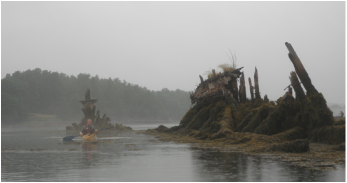When we finally arrived at Reid State Park (our planned launch site), we were informed that it would cost $12 to park there, so we turned around and launched (somewhat illegally) at the south end of Robinhood Cove. I hid my car in the woods so it wouldn't get towed. Another great reason to have a forest green car!
When we first set out, an ominously dark cloud had us worried, but we continued on and eventually it passed without incident. The overall route for the day included paddling up the length of Robinhood cove, heading up to the top of Knubble Bay, popping our heads out into Hockomock Bay, surviving the infamous 'Lower Hell Gate' on the way back into Knubble Bay, circumnavigating Macmanhan Island out in the Sheepscot River, and returning to the south end of Robinhood Cove. Check out the album below for photos and narration.
1. A persistent, slow, steady drizzle that kept us damp but cool for the majority of the day.
2. Intermittent bouts of fog that roll in unexpectedly, in a matter of minutes. These are caused by warm continental air flowing over the colder water, causing the moisture in the warm air to condense. When they roll in you can feel strong alternating breezes of hot, humid air and chilly, ocean air. At one point we watched a sailboat become engulfed in a thick layer of fog in front of us. We could only see the top of the mast sticking out of the layer. While we were watching we could hear a motorboat getting closer and closer to the sailboat, which was sounding its foghorn every minute or so. At the last minute the motorboat finally slowed down and veered off to the side of the sailboat. Throughout this whole business we stuck very close to the cliffs on our left to avoid any close encounters in the fog.
3. Strong tides that had us doing (scary according to me, fun according to Jeff) scary eddy turns and paddling against the current to get back. 'Lower Hell Gate' was supposed to have very fast moving water since it's relatively narrow and shallow, but we hit it just after high tide, so it wasn't too troublesome. In case you don't already know about the rule of twelfths, here's a basic rule of thumb that comes in useful when planning trips in tidal regions:
- Tides are spaced by 6 hours (ex. low tide at 11am, high tide at 5pm, low tide at 11pm)
- In the 1st and 6th hours, 1/12 of the water moves (between 11am and noon)
- In the 2nd and 5th hours, 2/12 (1/6) of the water moves
- In the 3rd and 4th hours, 3/12 (1/4) of the water moves
Ok, enough fractions. Overall lesson: The closer you are to slack tide (the moment when water stops moving in and starts moving out, or vice versa), the slower the water is moving.
Other fun fact: The higher north you are along the coast, the more the tides change (in Boothbay it was about 9 ft, in Acadia National Park next weekend it will be more like 11 ft).
4. Saltwater armpit chaffing. Enough said. Ow.
Distance: 18 miles
Duration: ~5.5 hours













 RSS Feed
RSS Feed

